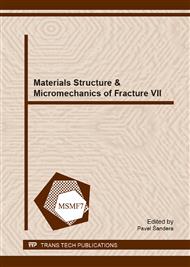p.71
p.75
p.79
p.83
p.87
p.92
p.96
p.100
p.107
3D Discrete Dislocation Dynamics Applied to a Motion of Low-Angle Tilt Boundaries
Abstract:
This paper presents a 3D discrete dislocation dynamics (DDD) model describing dislocation processes in crystals subjected to loadings at high temperatures. Smooth dislocations are approximated by short straight segments. Every segment is acted upon by a Peach-Koehler force obtained by summing up forces from all dislocation segments and a force due to the applied stress. The model addresses interactions between individual dislocations and rigid precipitates. The model is applied to a migration of low angle tilt boundaries (LATBs) characterized by different initial dislocation density and constrained by precipitates of different sizes. The calculations showed that, for applied shear stresses σxz lower than a certain threshold σcrit.(h), the LATB is inhibited by the precipitate field. For σxz above σcrit.(h), the LATB passes through the precipitate field. Some combinations of σxz and h lead to a decomposition of the LATB. The LATBs thus may evolve in three distinct modes depending on the initial microstructure. The threshold stress behaviour is known from creep tests of dispersion-strengthened NiCr alloys [1]. Furthermore, the critical stresses obtained from our calculations are below Orowan stresses for corresponding particle distribution. This behaviour has been also reported in creep experiments [1].
Info:
Periodical:
Pages:
87-91
Citation:
Online since:
November 2013
Authors:
Price:
Сopyright:
© 2014 Trans Tech Publications Ltd. All Rights Reserved
Share:
Citation:


